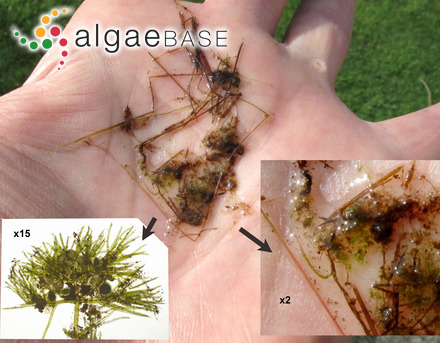Nitella confervacea (Brébisson) A.Braun ex Leonhardi 1863

Current name:
Nitella confervacea (Brébisson) A.Braun ex Leonhardi
Composite image showing size. Collected by Nick Stewart, Loch Druidibeg, South Uist. - 28 August 2016. C.F. Carter (chris.carter at 6cvw.freeuk.com)
Publication Details
Nitella confervacea (Brébisson) A.Braun ex Leonhardi 1863: 146
Published in: Leonhardi, H. von (1863). Weitere Characeen-Fundorte. Lotos 13: 129-132, 145-148.
Type Species
The type species (lectotype) of the genus Nitella is Nitella opaca (C.Agardh ex Bruzelius) C.Agardh.
Status of Name
This name is of an entity that is currently accepted taxonomically.
Basionym
Nitella gracilis var. confervacea Brébisson
Type Information
Lectotype locality: Argentan [probably Étang de Vrigny, south of Argentan, Orne Départment, France]; (Gregor & al. 2012: 394 (Table 1), 393) Lectotype: Brébisson; 1837; PC; 0719925 (Gregor & al. 2012: 394 (Table 1)) Notes: Lectotype: Specimen is labeled (1) "Herb. G. Thuret/Brébisson dedit 1850/ Nitella gracilis V.confervacea/ Argentan Jt. 1837" and (2) " Herbier Museum Paris Cryptogamie PC0719925".
General Environment
This is a freshwatermarine species.
Description
This is the most tiny and delicate charophyte in the area. The plants are up to 4 cm high and dark green. It is commonly rich branched and the whorls are often forming small heads. The axis is less than 300 µm in diameter. The 6-8 branchlets in each whorl are repeatedly divided. The dactyls are 2-celled with tapering end-cells. The species is monoecious. The gametangia are regularly on the first branchlet furcations. The oogonium is yellow brown to black, up to 450 µm long and has prominent ridges and granulate membrane. The antheridium is up to 250 µm in diameter. The plants are often covered by soft sediment and therefore difficult to find. It is often found by coincidence.
Habitat
Nitella confervacea is found in different types of waters, from small ponds to lakes. The lakes can be of different types from, both oligotrophic (Lobelia-lakes) and mesotrophic (Potamogeton- lakes). It is also found in slightly brackish water in the Baltic Sea and in Drammensfjorden in Norway. It is found in shallow water, down to a depth of 40-50 cm.
N. confervacea is annular. It is generally richly fertile, and fertile plants are found from July. Ripe oospores are found from August onwards.
Created: 11 April 2002 by M.D. Guiry.
Last updated: 11 May 2020
Verification of Data
Users are responsible for verifying the accuracy of information before use, as noted on the website Content page.
Linking to this page: https://www.algaebase.org/search/species/detail/?species_id=35595
Citing AlgaeBase
Cite this record as:
M.D. Guiry in Guiry, M.D. & Guiry, G.M. 11 May 2020. AlgaeBase. World-wide electronic publication, National University of Ireland, Galway. https://www.algaebase.org; searched on 02 January 2025
 Request PDF
Request PDF














